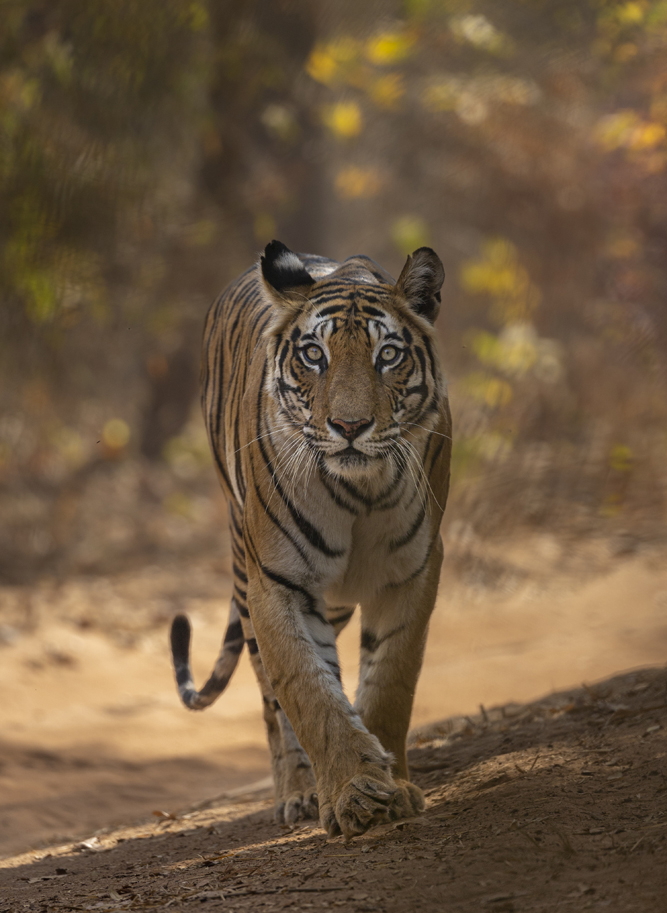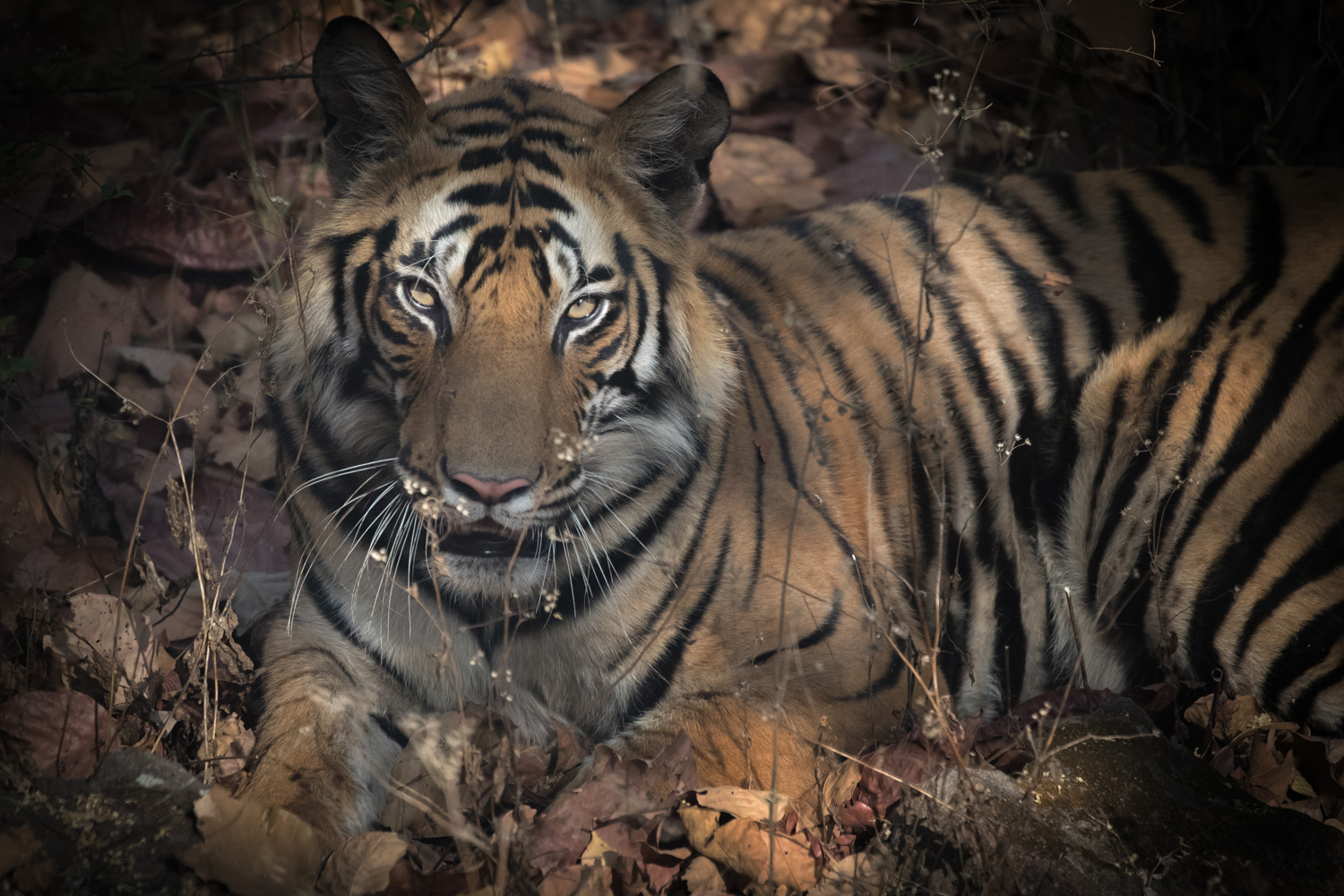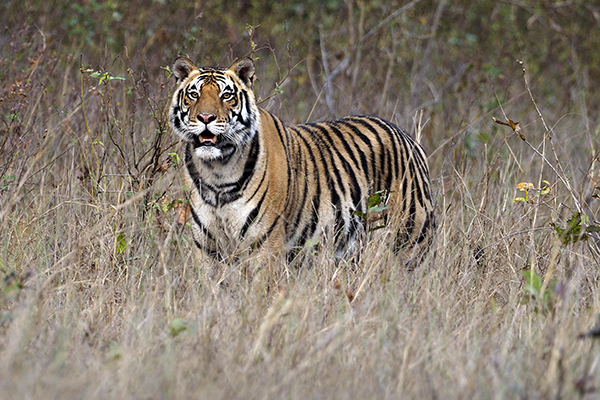Bandhavgarh National Park has one of the highest densities of tigers in India. Talking to Amit, the lodge owner of our park jungle lodge in the weeks before our trip, he assured me that “Bandhavgarh was rocking with tigers this season”—and he was right! However, the forest reserves of Madhya Pradesh have a great deal more to offer besides tigers!
Technically our tour began in Delhi, meeting the group members for dinner and drinks at the 5-star Radisson Blue hotel. Not one to miss a birding opportunity before the guests arrived, I spent the morning on the hotel roof garden where black kite, shikra, tailor bird and numerous palm squirrels were scurrying between the high rises. The following morning we took our domestic flight to Jabalpur. Looking out of the plane’s window as we prepared to land, cityscapes gave way to rocky sandstone hilltops, rising above a green deciduous forest. The drive to the lodge took us through numerous villages where the sharp-eyed traveler can spot several bird species along the way such as white-throated kingfishers and Indian rollers which frequent human settlements. We did a rest stop halfway for chai and to admire the vivid red flowers of the flame of the forest trees which are at their best in April. A warm welcome awaited us at Bandhavgarh Jungle Lodge. There we discussed our plans for the following 7 days of wildlife packed game drives.
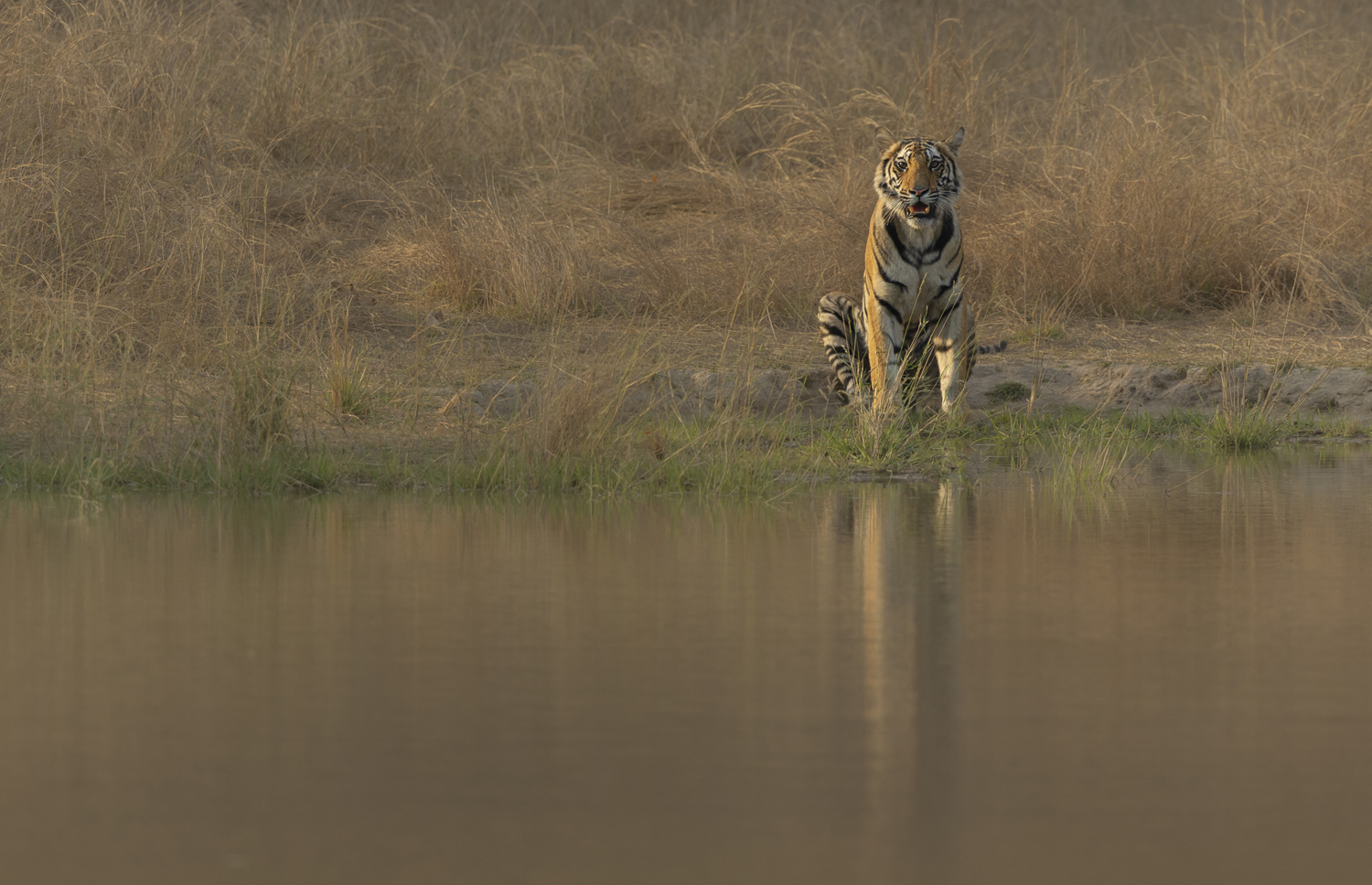
On our first day in the park, it would be an understatement to say that things got off to an early start! A little more than 10 minutes through the Tala Gate we heard alarm calls from langur monkeys and spotted deer alerting us to a young male tiger as he passed through open grassland. Sometimes the build up to a tiger sighting can be better than the encounter itself while following tracks along the road edges, listening for alarm calls, and trying to figure out where the tigers are headed. Shortly after our first brief glimpse of the young male, we were rewarded with a female swaggering along a backlit track towards us. All vehicles must maintain a respectable distance from the tigers in Bandhavgarh and this meant she was relaxed enough to lay down on the road, stretch and take a brief nap. All this with beautiful, dappled light which made for a great photo opportunity.
Early morning is best for tiger movement, and therefore it makes sense to focus on cats (leopards and sloth bears too) until around 9 AM when we would normally take a breakfast stop. It’s a 5 AM start with park gate entry at around 6 AM—so there is plenty of morning tiger time. After that, we look for photo opportunities with the park’s some 250 bird species, deer, wild cattle, and antelope.
Later that first day afternoon, one of Bandhavgarh’s star tigresses known as Spotty made an appearance at one of the few remaining water-filled sections of a shallow river. To our delight she had two of her three subadult cubs following her. They approached us along the riverbank and passed between our vehicles offering a nice, natural framing amidst the jungle foliage.
At dinner that evening I was pleasantly surprised to hear that another of our vehicles had added a further 3 tigers (another mother and cubs) to our total. Certainly, a record in any of the years I have spent in Central India’s parks. There were smiles all round at dinner as we recalled our big cat encounters.

Over the past two years, a herd of over 50 wild elephants have moved back into the park after decades of absence. These forest giants are shy of people, taking tentative steps as they emerge from cover. Low, rumbling calls and breaking branches are the first things that alert you to their presence. Imagine our excitement when a herd made its presence known, heading towards a water body where an adult tiger was already cooling off. His ears pricked up well before we were aware of the elephant’s approach. Then, slowly in groups of three or four the elephants cautiously entered the water. There were babies amongst the heard and whilst it would be highly unlikely a tiger would take on these leviathans, we held our breath not knowing what to expect. It transpired that both tiger and elephant kept their distance from each other. The elephants bathed, with all the playing and water spraying we could have hoped for. But they didn’t hang around for more than a few minutes, all the while keeping one eye on the motionless cat.
It is also worth mentioning that a lone bull has taken to raiding the crops and gardens of some of the lodges—including ours. One evening I woke to a commotion, thinking I had slept through my alarm I jumped out of bed and looked out of the window where flashlights glanced over the nearby bamboo thicket. On drawing back the curtain I was greeted by a trunk, moving the furniture around on the veranda, no doubt looking for dropped morsels of food. The lodge staff tried their best to discourage the animal but unlike the rest of the heard, this guy seemed indifferent to the presence of people. After that first encounter, several of our guests requested that they could be awakened to see our nocturnal visitor. Getting up meant for some great memories for us—less so for the lodge staff having to fix broken gates and re-plant the kitchen garden.
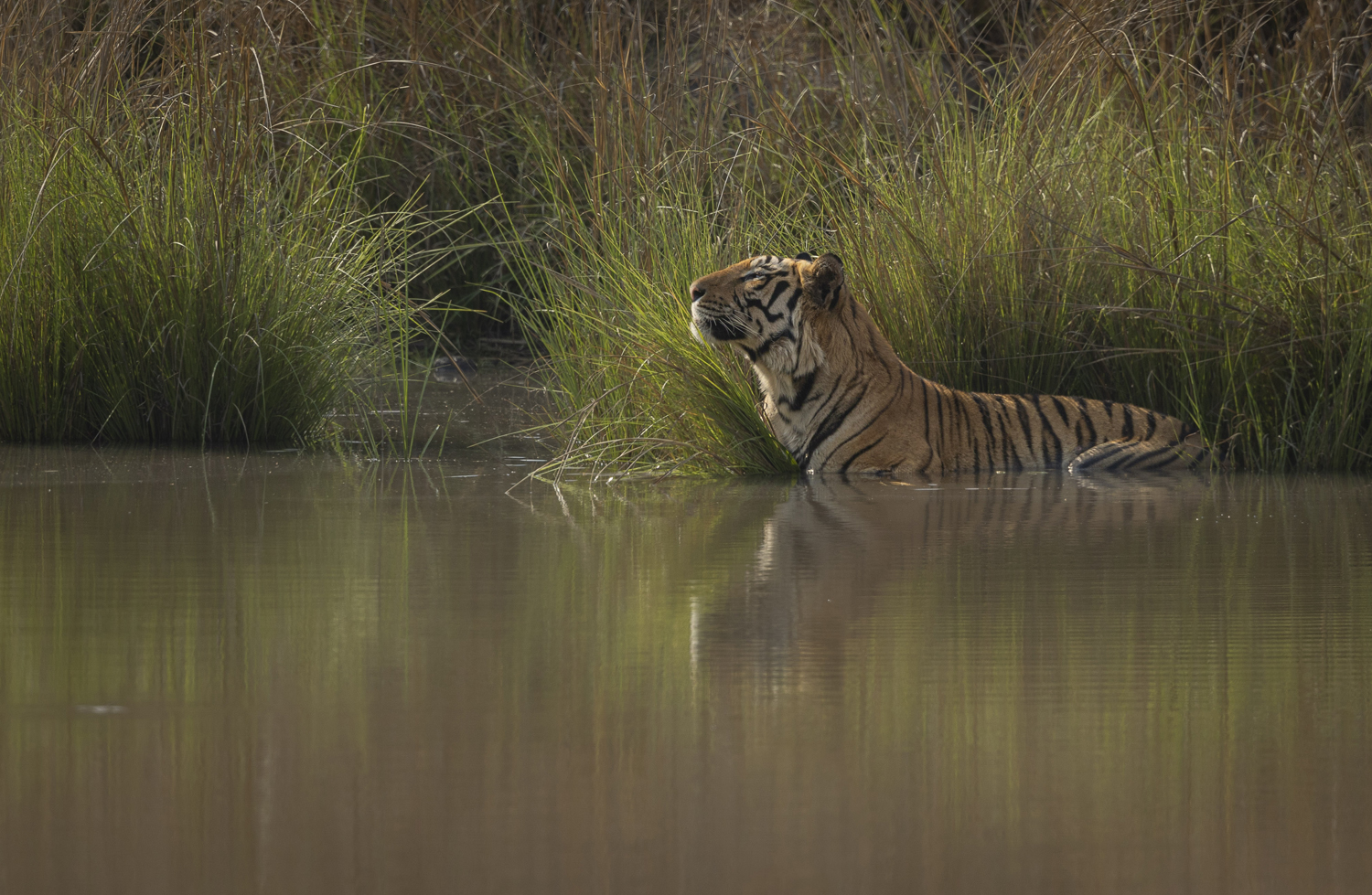
Tiger sightings were consistent throughout the rest of the trip. A few of our vehicles were lucky enough to see a mother and three very young cubs, perhaps only a few months out of the den. The infamous tigress sisters, Spotty and Dotty and their older offspring made up most of our other sightings. Bandhavgarh really is brimming with tigers now! The elephants returned on two more occasions making sure that everyone got to see them, with one encounter comprising some 20 plus animals bathing at a necessarily large waterhole.
Other carnivores worth a mention such as leopard made a couple of appearances, two individuals apparently lounging in a banyan tree were most likely chased up there by a nearby tiger. We also saw a single animal amidst the tall saccharum grass of one of the parks open meadows. Jackal were spotted frequently, often on the road where they would confidently stop to inspect vehicles and their occupants. Day two and day six both had early morning encounters with sloth bears who prefer to feed at dawn and dusk.

Our bird list was extensive, and the best time to focus on them was when the vehicles were parked as we listened for alarm calls. On just such an occasion we sat beside a small pool, all that was left of an otherwise dry riverbed. The surrounding trees were alive with the colorful plumage and melodic calls of golden oriole. In the same cluster of trees, we also spotted black-naped monarch (a stunning vivid blue flycatcher), golden leafbird and no less than three species of kingfishers—white throated, common, and pied. A fourth species, the stork billed kingfisher, was frequently spotted at one of the well-used tiger bathing spots, its distinctive laughing call making its presence known. Sometimes it pays to switch off the tiger focus and look at what else is around, especially bird wise. A personal favorite is the lesser adjutant stork, similar but a little smaller than a marabou, often seen in woodland as they search with a slow methodical gate for invertebrates and reptiles amongst leaf litter.

Other notable bird species where we had both good views and photographic opportunities were changeable hawk eagle, serpent eagle, blue-bearded bee-eater, common hawk cuckoo, greater coucal, painted stork, red-naped ibis, spotted owlet, mottled wood owl, brown fish owl, rufous tree pie, oriental magpie-robin, Egyptian vulture and white-rumped sharma. A couple of our vehicles also encountered a Bengal monitor lizard, easily over a meter in length, picking off fallen caterpillars as it wandered along the roadside.
An emotional farewell dinner was taken under the stars. Occasional alarm calls in the distance reminded us that the tigers were often closer than you might think—even if you don’t see them. After our group thanked the resident naturalists, jeep drivers and lodge staff that looked after us so well, I was reminded of the importance of wildlife tourism in tiger country. The Park supports many hundreds of jobs that in turn secure the future of Bandhavgarh as a sanctuary for wildlife and a future for its tigers.
